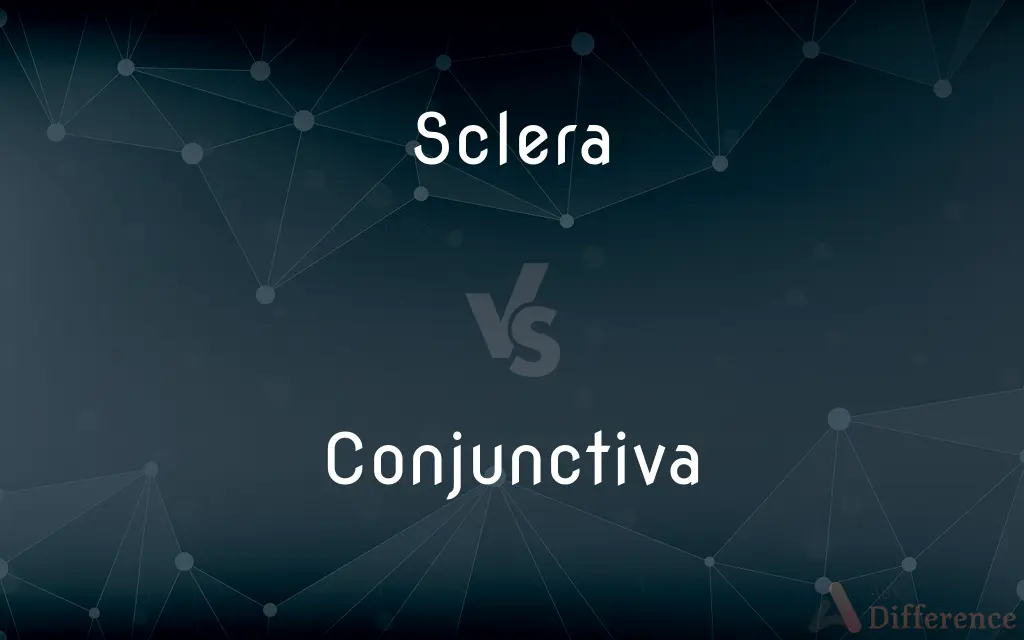Sclera vs. Conjunctiva — What's the Difference?
Edited by Tayyaba Rehman — By Fiza Rafique — Updated on September 21, 2023
The sclera is the white, fibrous outer layer of the eyeball, providing structure and protection. The conjunctiva is a thin, transparent membrane that covers the front part of the eye and lines the inside of the eyelids.

Difference Between Sclera and Conjunctiva
Table of Contents
ADVERTISEMENT
Key Differences
The sclera and conjunctiva are both integral components of the eye, but they serve different purposes. The sclera is the white, tough outer covering of the eyeball, extending from the cornea to the optic nerve. It provides protection and helps maintain the eye's shape. In contrast, the conjunctiva is a clear, thin membrane that covers the front part of the eye and lines the eyelids, helping to keep them moist.
Structurally, the sclera is opaque and fibrous, composed primarily of collagen fibers that give it its rigidity. The conjunctiva, on the other hand, is transparent and contains many small blood vessels, making it more susceptible to becoming red or inflamed. It serves as a protective barrier against dust and microbes and aids in lubrication by producing mucus and tears.
In terms of location, the sclera forms the "white" of the eye and is contiguous with the cornea, while the conjunctiva lies on top of the sclera, covering it and extending to the inside of the eyelids. The sclera is not generally visible in its entirety due to its location within the eye socket, but the conjunctiva can be more easily seen and examined, especially when inflamed or irritated.
Both the sclera and conjunctiva can be affected by various conditions. For example, inflammation of the sclera is known as scleritis, while inflammation of the conjunctiva is called conjunctivitis or "pink eye." Medical procedures involving these structures are also different; for instance, surgeries to correct vision problems usually don't involve the sclera, but may involve the conjunctiva.
Comparison Chart
Function
Structural support
Lubrication & protection
ADVERTISEMENT
Location
Forms the "white" of the eye
Covers sclera & lines eyelids
Transparency
Opaque
Transparent
Vulnerabilities
Less prone to inflammation
Prone to inflammation
Related Conditions
Scleritis
Conjunctivitis
Compare with Definitions
Sclera
Extends from the cornea to the optic nerve.
The sclera is contiguous with the cornea at the front of the eye.
Conjunctiva
A thin, transparent membrane covering the eye.
The conjunctiva helps keep the eye moist.
Sclera
Provides protection to the eye's inner components.
The sclera serves as a protective barrier for the inner eye.
Conjunctiva
Contains small blood vessels.
The blood vessels in the conjunctiva can become inflamed.
Sclera
Can be affected by conditions like scleritis.
Inflammation of the sclera is known as scleritis.
Conjunctiva
Produces mucus and tears for lubrication.
The conjunctiva aids in keeping the eye lubricated.
Sclera
Composed mainly of tough, fibrous tissue.
The rigidity of the sclera helps maintain the eye's shape.
Conjunctiva
Lines the inside of the eyelids.
The conjunctiva extends from the eye to the eyelids.
Sclera
The white outer layer of the eyeball.
The sclera gives the eye its white appearance.
Conjunctiva
The conjunctiva is a tissue that lines the inside of the eyelids and covers the sclera (the white of the eye). It is composed of non-keratinized, stratified squamous epithelium with goblet cells, stratified columnar epithelium and stratified cuboidal epithelium (depending on the zone).
Sclera
The sclera, also known as the white of the eye or, in older literature, as the tunica albuginea oculi, is the opaque, fibrous, protective, outer layer of the human eye containing mainly collagen and some crucial elastic fiber. In humans, and many other animals, the whole sclera is white, contrasting with the coloured iris, but in some other mammals the visible part of the sclera matches the colour of the iris, so the white part does not normally show.
Conjunctiva
The mucous membrane that covers the front of the eye and lines the inside of the eyelids.
Sclera
The white outer layer of the eyeball. At the front of the eye it is continuous with the cornea.
Conjunctiva
The mucous membrane that lines the inner surface of the eyelid and the exposed surface of the eyeball.
Sclera
The tough white fibrous outer envelope of tissue covering all of the eyeball except the cornea. Also called sclerotic, sclerotic coat.
Conjunctiva
(anatomy) A clear mucous membrane that lines the inner surface of the eyelid and the exposed surface of the eyeball or sclera.
Bulbar conjunctiva
Sclera
(anatomy) The white of the eye; the tough outer coat of the eye that covers the eyeball except for the cornea.
Conjunctiva
The mucous membrane which covers the external surface of the ball of the eye and the inner surface of the lids; the conjunctival membrane.
Sclera
Whitish fibrous membrane (albuginea) that with the cornea forms the outer covering of the eyeball
Conjunctiva
A transparent membrane covering the eyeball and under surface of the eyelid
Conjunctiva
Prone to conditions like conjunctivitis.
Conjunctivitis is an inflammation of the conjunctiva.
Common Curiosities
What is the sclera?
The sclera is the white, fibrous outer layer of the eyeball that provides structure and protection.
How do the sclera and conjunctiva differ in function?
The sclera provides structural support, while the conjunctiva offers lubrication and protection.
Which one is transparent?
The conjunctiva is transparent, while the sclera is opaque.
What is conjunctivitis?
Conjunctivitis is inflammation of the conjunctiva, commonly known as "pink eye."
What is the sclera made of?
The sclera is made primarily of tough, fibrous tissue.
How does the sclera maintain eye shape?
The sclera's rigidity helps maintain the shape of the eye.
What is the conjunctiva?
The conjunctiva is a thin, transparent membrane that covers the front part of the eye and lines the inside of the eyelids.
Can the sclera get inflamed?
Yes, inflammation of the sclera is known as scleritis.
Is the sclera visible?
The sclera forms the "white" of the eye and is partially visible.
What roles do these parts play in vision?
While neither directly affects vision, both are essential for eye health and protection.
Where is the conjunctiva located?
The conjunctiva covers the sclera and lines the inside of the eyelids.
Is the conjunctiva easily irritated?
Yes, the conjunctiva is more susceptible to irritation and inflammation.
Can both be affected by disease?
Yes, both can be affected by various conditions, requiring different treatments.
Does the conjunctiva produce tears?
Yes, the conjunctiva contributes to tear production for eye lubrication.
How are they examined medically?
The sclera is generally viewed using ophthalmic equipment, while the conjunctiva can be easily examined.
Share Your Discovery

Previous Comparison
Payment vs. Remittance
Next Comparison
Hypothermia vs. HyperthermiaAuthor Spotlight
Written by
Fiza RafiqueFiza Rafique is a skilled content writer at AskDifference.com, where she meticulously refines and enhances written pieces. Drawing from her vast editorial expertise, Fiza ensures clarity, accuracy, and precision in every article. Passionate about language, she continually seeks to elevate the quality of content for readers worldwide.
Edited by
Tayyaba RehmanTayyaba Rehman is a distinguished writer, currently serving as a primary contributor to askdifference.com. As a researcher in semantics and etymology, Tayyaba's passion for the complexity of languages and their distinctions has found a perfect home on the platform. Tayyaba delves into the intricacies of language, distinguishing between commonly confused words and phrases, thereby providing clarity for readers worldwide.
















































